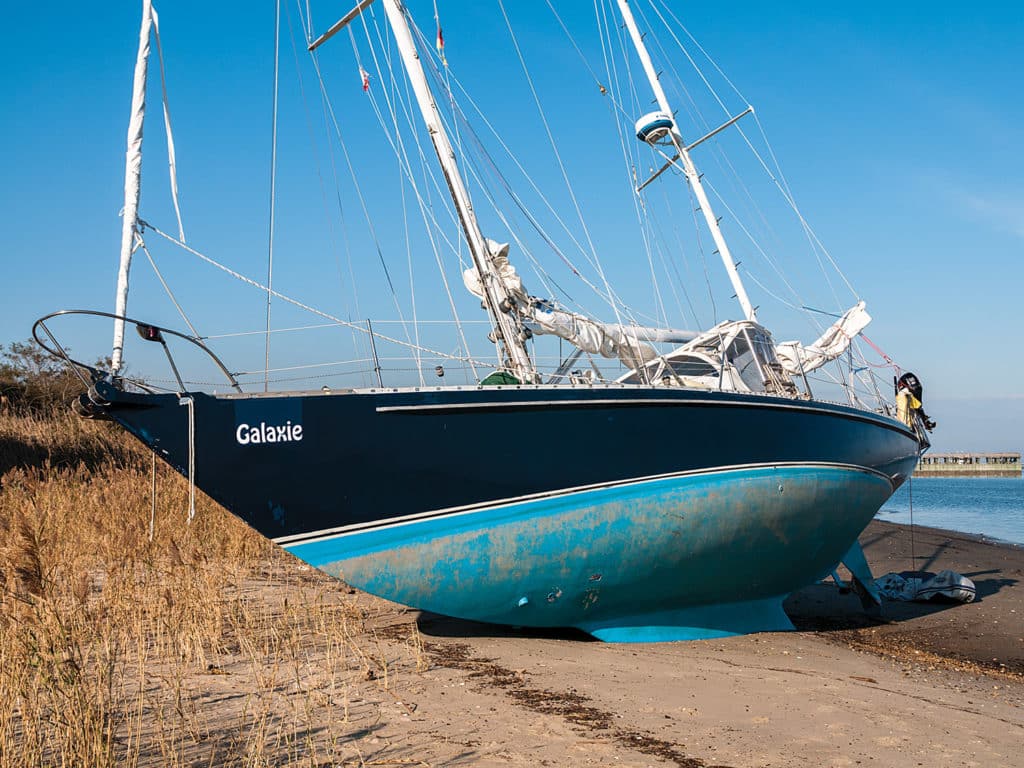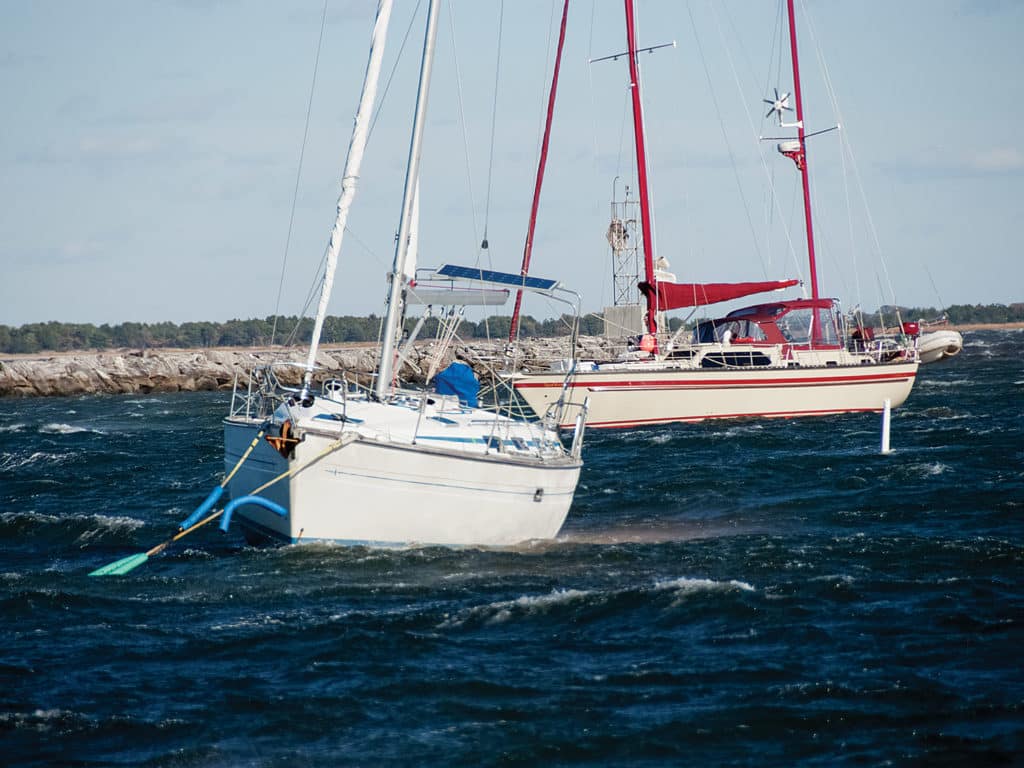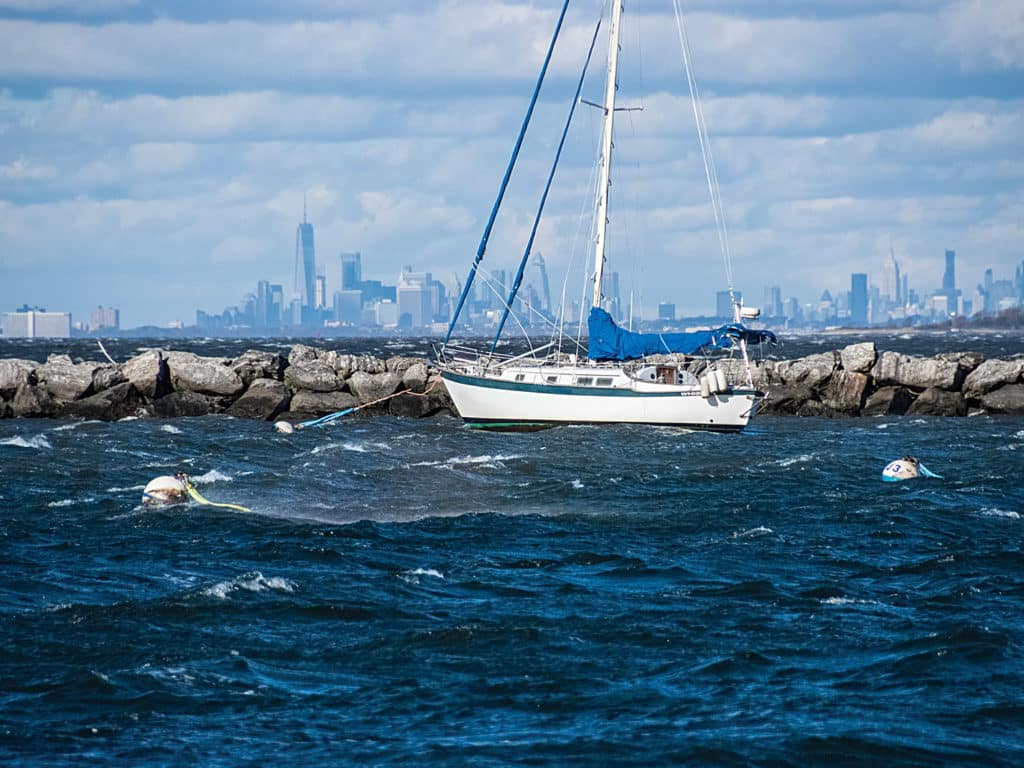
By mid-October of 2018, on our trip south from New England, the winds showed disturbing signs of flexing muscles beyond the normal conditions one would expect to encounter for that time of the year. Reaching across Massachusetts Bay from Gloucester, Massachusetts, to Newport, Rhode Island, following a forecast of breezes gusting from 25 to 30 knots, we soon were running under our “winter rig” of triple-reefed main and a small staysail. With gusts of 35 knots, even with the shore only 12 miles to windward, we had seas fit for open ocean. There was a menacing bite in the gusts and the sound of hissing, crashing seas in the breaking wave crests. Some days later, blasting our way by Point Judith to Stonington, Connecticut, a northwester whistling off the land kept our good old Mason 44, Frances B, on her beam ends despite our shortened sail plan. Again, there was a fresh punch in the wind. Nearly all the harbors in Long Island Sound are filled by mooring fields. In the weather that we now anticipated ahead of us, hanging out on an unfamiliar mooring began to seem a bit precarious. You never know what exactly is down there to secure your boat when the wind begins to howl. Anything more than 25 knots can be a challenge for a mooring. A lot of experience and knowledge goes into installing reliable moorings and planning the layout and location of a mooring field. Whenever possible, we rely on our own heavy ground tackle, which we heartily recommend. Sometimes, that option isn’t available. And owners who keep their boats on moorings seasonally, in towns like Newport where you aren’t permitted to anchor for weeks or months at a time, also need to be aware of mooring pros and cons.
In basic terms, a mooring consists of something heavy on the bottom attached to a chain that eventually terminates in a buoy with a pendant to a boat. That weight can be mushroom anchors, one-armed mushroom anchors, pyramid-shaped cast iron or even chunks of concrete blocks. If you ask a local launch operator about a mooring’s weight, the answer will generally be 500 or 1,000 pounds. However, a big concrete chunk loses about 42 percent of its weight when submerged, and it’s a certainty that the launch drivers are referencing the weights on shore.

Then there’s the matter of how often the various metal components are checked: the U-bolts, chains, shackles and swivels, all of them submerged in the murky depths. Down there, stuff happens. We’re reminded of the story of an owner of a large boatyard in Maine who maintains a couple of moorings in distant Rockland for his customers. Every spring a diver inspects the gear, so a phone call from the Rockland harbormaster that the yard owner’s son’s sailboat just washed up on the beach was a surprise. Thanks to calm weather, little damage occurred. When contacted, the diver who’d recently inspected the mooring said he thought the chain still had enough steel to last another season. Clearly, that wasn’t the case.
Above water, a mooring can at least be inspected to see that the shackles are moused to prevent unscrewing and the pendant diameter is robust enough to support your boat in heavy squalls. If tempted to pick up a mooring, make a visual inspection of it and take into account the fetch from the direction of the strongest forecast wind. While waiting out a frontal passage at Atlantic Highlands near Sandy Hook, New Jersey, we had a close-up view of a sturdy, oceangoing ketch high and dry, its keel and rudder already partially buried in sand, a frayed double-line pendant still hanging from its bow. These lines must have broken during the violent easterly storm we’d weathered a few days earlier. A breakwater protects this harbor from all winds except easterly ones; it’s 1.5 nautical miles to land in that direction. In the 30-knot westerly we experienced in Atlantic Highlands, despite a protecting breakwall half a mile away, the moored boats dipped their bows deep in nasty chop and tacked violently in gusts. At the same time our boat, in the same mooring field, stayed relatively steady since we had anchored with a lot of chain out.
Yes, most of the time, especially out of season, you can find among the moorings a patch of ground large enough to anchor — although in most circumstances anchoring in mooring fields is rarely allowed. Most moorings are laid along straight lines which, after taking into account the wind direction and current flow, makes it fairly easy to imagine where the mooring weights lie on the bottom. For the easterly storm that swept the ketch ashore in Atlantic Highlands, we had escaped to Port Jefferson, Long Island. There is a bluff there that shelters the place from anything between northwest to east. Naturally, the mooring field uses the most desirable location. After searching back and forth we found a hole; its average 40-foot depth discouraged the mooring installers from using it. With our 400-foot-long load of chain, we could still lay out a very good scope. Not long after, two launch operators warned that by next morning we’d be on the beach. “Better take a mooring,” they advised. “We tie some big boats there, the blocks are 1,000 pounds!” We didn’t think that was adequate for our 44-footer in view of the 40-knot forecast.

Naturally, in some harbors a very dense mooring field may lack a recognizable pattern. You should always assume, after finding an opening between the floats, that some lost moorings litter the bottom, and your anchor can foul on them. So if you decide to drop your hook there, prepare to get yourself free with a trip line: a ½-inch floating line, a few feet longer then the depth at high tide, with one end tied to the crown of the anchor, the other to a float. The problem with trip lines is that, as the boat swings, the chain can tangle with the trip line and pull the float under. It often takes two people to do it right. An anchor dropped rapidly spins and may also wind the trip line around the chain. Lower the anchor slowly as the helper pays out the trip line. If by next morning the float has vanished, don’t fret. As the chain comes in the float will soon pop up. Bring it to the bow with a boat hook and pull hard; on heavy boats lead the trip line around the capstan.
We noticed that after forecasts of fearsome weather, many anchored boats moved to moorings. Personally, I feel that for a boat with adequate and proven ground tackle, the opposite action would be safer. Chain anchor rode is best, with a scope of 4-to-1 for a breeze, increased to 6-to-1 or more as the wind goes above 25 knots. Boats that have anchors with chain/line combinations need to use more scope, 10-to-1 in some conditions. Shackling a second anchor in tandem behind the main bower helps reduce the necessary scope. Make sure both anchors ride on the length of chain to avoid chafing the line part of the anchor rode. I’ve found that this tactic is often favored by French sailors; it’s a complex solution that can turn the job of bringing up the anchor gear into a time-consuming struggle to avoid gouging the bow, crushing fingers and so on. In my opinion, the question of whether to moor or anchor has a simple answer: Nothing beats a long scope of chain attached to a modern anchor, of which there are a variety of good models. Just make sure the anchor is rated for a boat larger than yours.
Tom and Nancy Zydler make an annual summer pilgrimage to northern climes aboard their Mason 44, Frances B, from their winter base off the coast of Georgia.








